key CHEVROLET ASTRO PASSENGER 1994 1.G User Guide
[x] Cancel search | Manufacturer: CHEVROLET, Model Year: 1994, Model line: ASTRO PASSENGER, Model: CHEVROLET ASTRO PASSENGER 1994 1.GPages: 340, PDF Size: 16.86 MB
Page 74 of 340
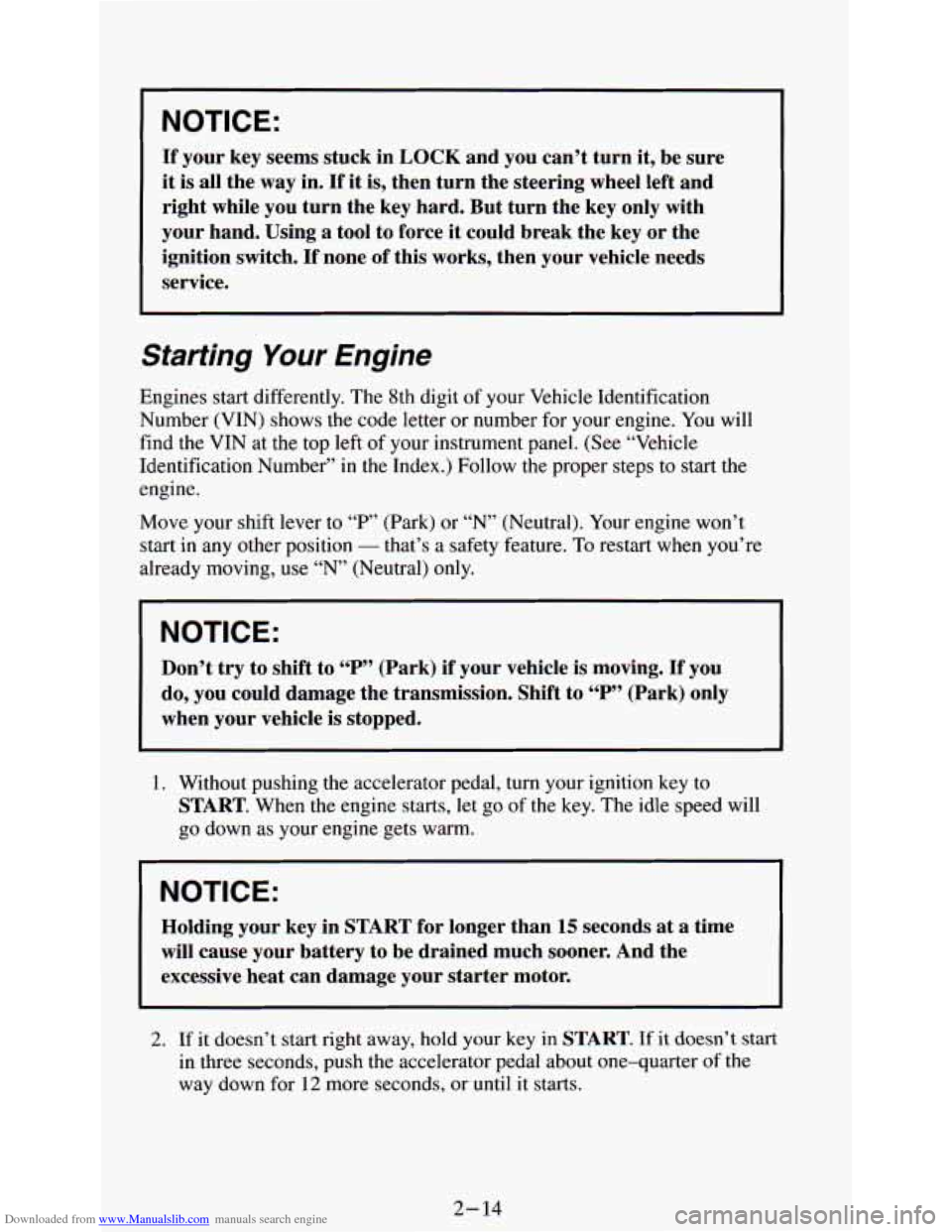
Downloaded from www.Manualslib.com manuals search engine I 1
I NOTICE:
If your key seems stuck in LOCK and you can’t turn it, be sure
it is
all the way in. If it is, then turn the steering wheel left and
right while you turn the key hard. But turn the key only with
your hand. Using
a tool to force it could break the key or the
ignition switch.
If none of this works, then your vehicle needs
service.
Farting Your Engine
Engines start differently. The 8th digit of your Vehicle Identification
Number (VIN) shows the code letter or number for your engine. You will
find the VIN at the top left of your instrument panel. (See “Vehicle
Identification Number”
in the Index.) Follow the proper steps to start the
engine.
Move your shift lever to
“P’ (Park) or “N” (Neutral). Your engine won’t
start in any other position
- that’s a safety feature. To restart when you’re
already moving, use
“N” (Neutral) only.
NOTICE:
Don’t try to shift to “P” (Park) if your vehicle is moving. If you
do, you could damage the transmission. Shift
to “P” (Park) only
when your vehicle
is stopped.
1. Without pushing the accelerator pedal, turn your ignition key to
START. When the engine starts, let go of the key. The idle speed will
go down as your engine gets warm.
NOTICE:
Holding your key in START for longer than 15 seconds at a time
will cause your battery to be drained much sooner. And the
excessive heat can damage your starter motor.
2. If it doesn’t start right away, hold your key in START. If it doesn’t start
in three seconds, push the accelerator pedal about one-quarter of the
way down for
12 more seconds, or until it starts.
2- 14
Page 75 of 340
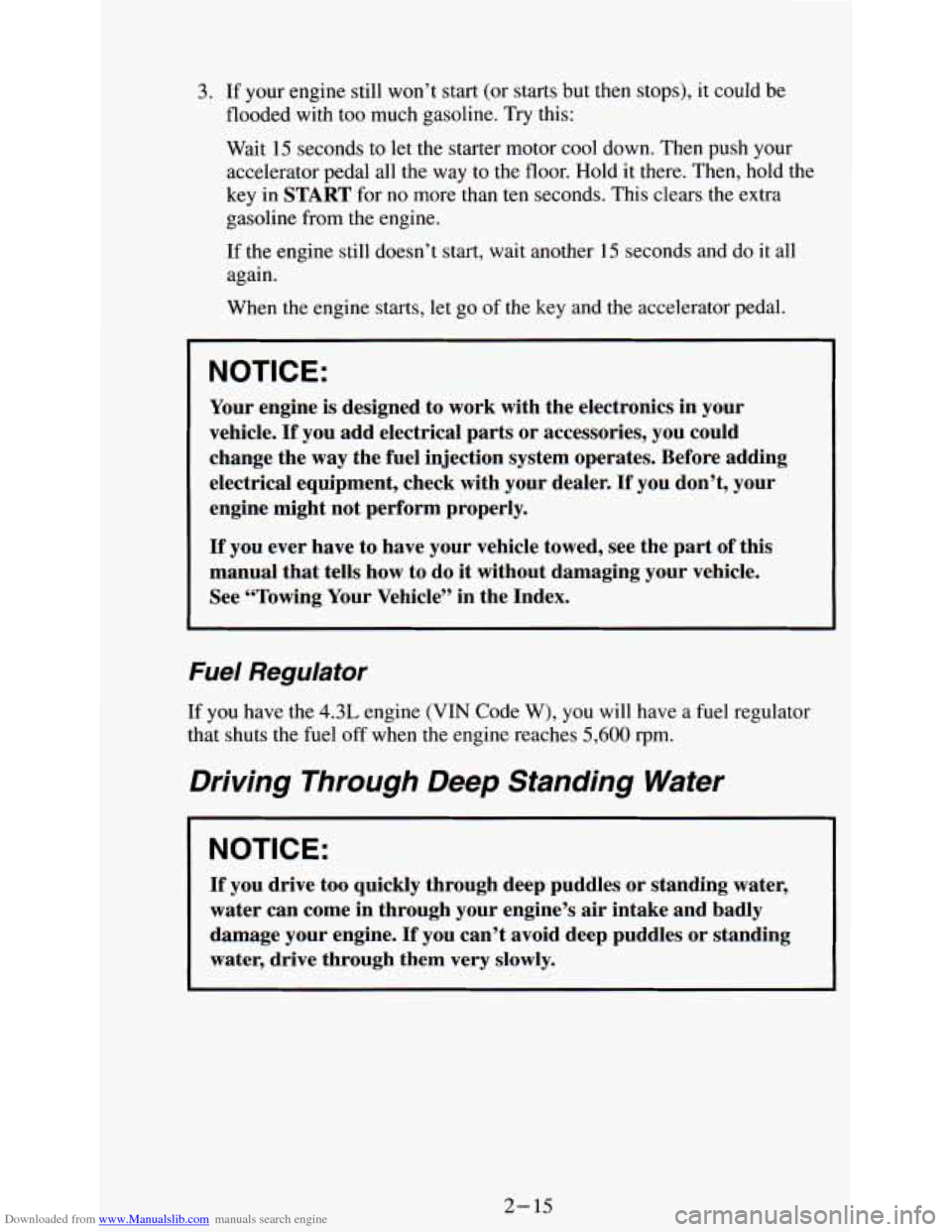
Downloaded from www.Manualslib.com manuals search engine 3. If your engine still won’t start (or starts but then stops), it could be
flooded with too much gasoline. Try this:
Wait 15 seconds to let the starter motor cool down. Then push your
accelerator pedal all the way to the floor. Hold it there. Then, hold the
key in
START for no more than ten seconds. This clears the extra
gasoline from the engine.
If the engine still doesn’t start, wait another 15 seconds and do it all
again.
When the engine starts, let go of the key and the accelerator pedal.
NOTICE:
Your engine is designed to work with the electronics in your
vehicle.
If you add electrical parts or accessories, you could
change the way the fuel injection system operates. Before adding
electrical equipment, check with your dealer.
If you don’t, your
engine might not perform properly.
If you ever have to have your vehicle towed, see the part of this
manual that tells how to do it without damaging your vehicle.
See “Towing Your Vehicle” in the Index.
Fuel Regulator
If you have the 4.3L engine (VIN Code W), you will have a fuel regulator
that shuts the fuel off
when the engine reaches 5,600 rpm.
Driving Through Deep Standing Water
NOTICE:
If you drive too quickly through deep puddles or standing water,
water can come in through your engine’s air intake and badly
damage your engine.
If you can’t avoid deep puddles or standing
water, drive through them very slowly.
2- 15
Page 78 of 340
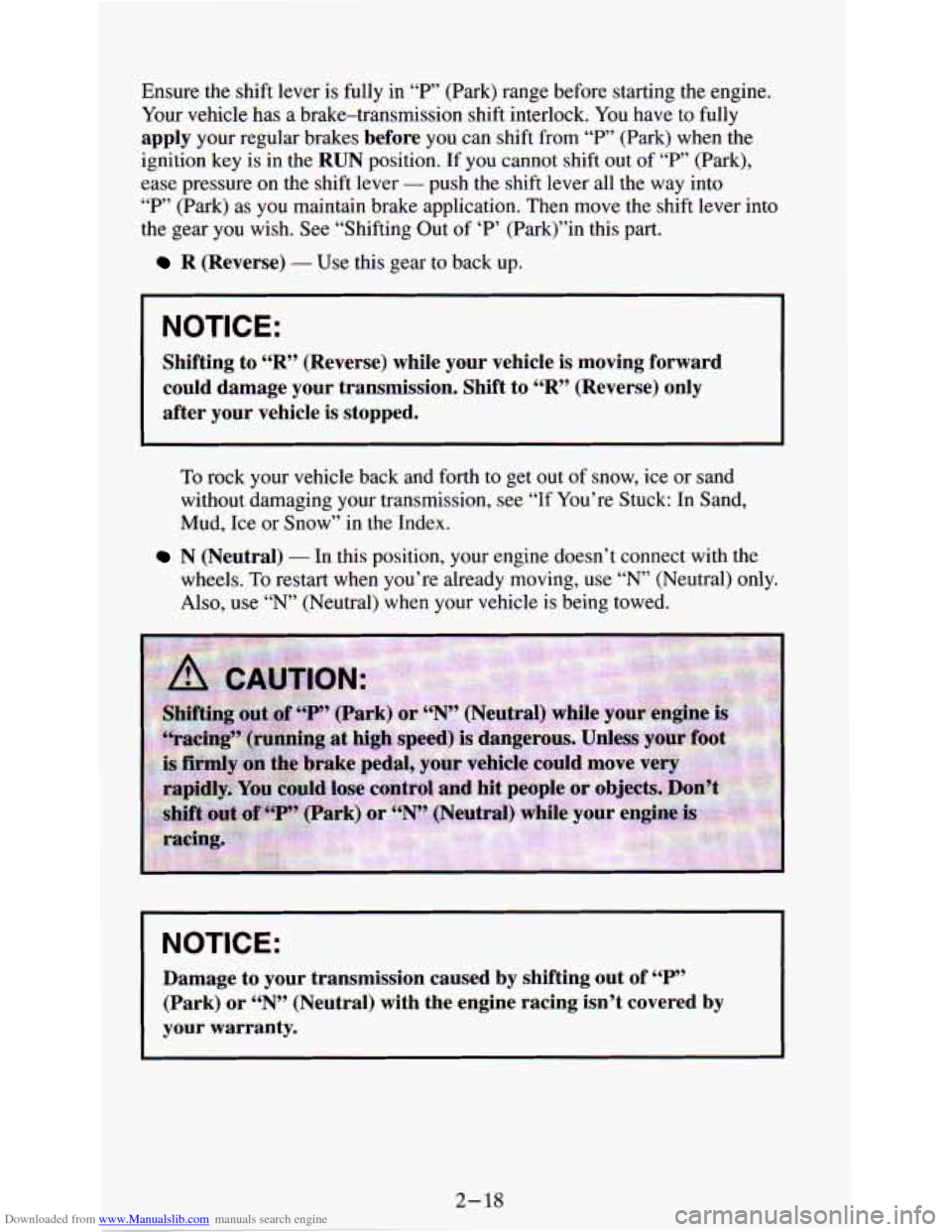
Downloaded from www.Manualslib.com manuals search engine Ensure the shift lever is fully in “P” (Park) range before starting the engine.
Your vehicle has
a brake-transmission shift interlock. You have to fully
apply your regular brakes before you can shift from “P” (Park) when the
ignition key is in the
RUN position. If you cannot shift out of “P’ (Park),
ease pressure on the shift lever
- push the shift lever all the way into
“P” (Park)
as you maintain brake application. Then move the shift lever into
the gear you wish. See “Shifting Out of ‘P’ (Park)”in this part.
R (Reverse) - Use this gear to back up.
NOTICE:
Shifting to “R” (Reverse) while your vehicle is moving forward
could damage your transmission. Shift to
“R” (Reverse) only
after your vehicle is stopped.
To rock your vehicle back and forth to get out of snow, ice or sand
without damaging your transmission, see
“If You’re Stuck: In Sand,
Mud, Ice
or Snow” in the Index.
N (Neutral) - In this position, your engine doesn’t connect with the
wheels. To restart when you’re already moving, use
“N’ (Neutral) only.
Also, use
“N” (Neutral) when your vehicle is being towed.
-
NOTICE:
Damage to your transmission caused by shifting out of “P”
(Park) or “N” (Neutral) with the engine racing isn’t covered by\
your warranty.
1
2- 18
Page 81 of 340
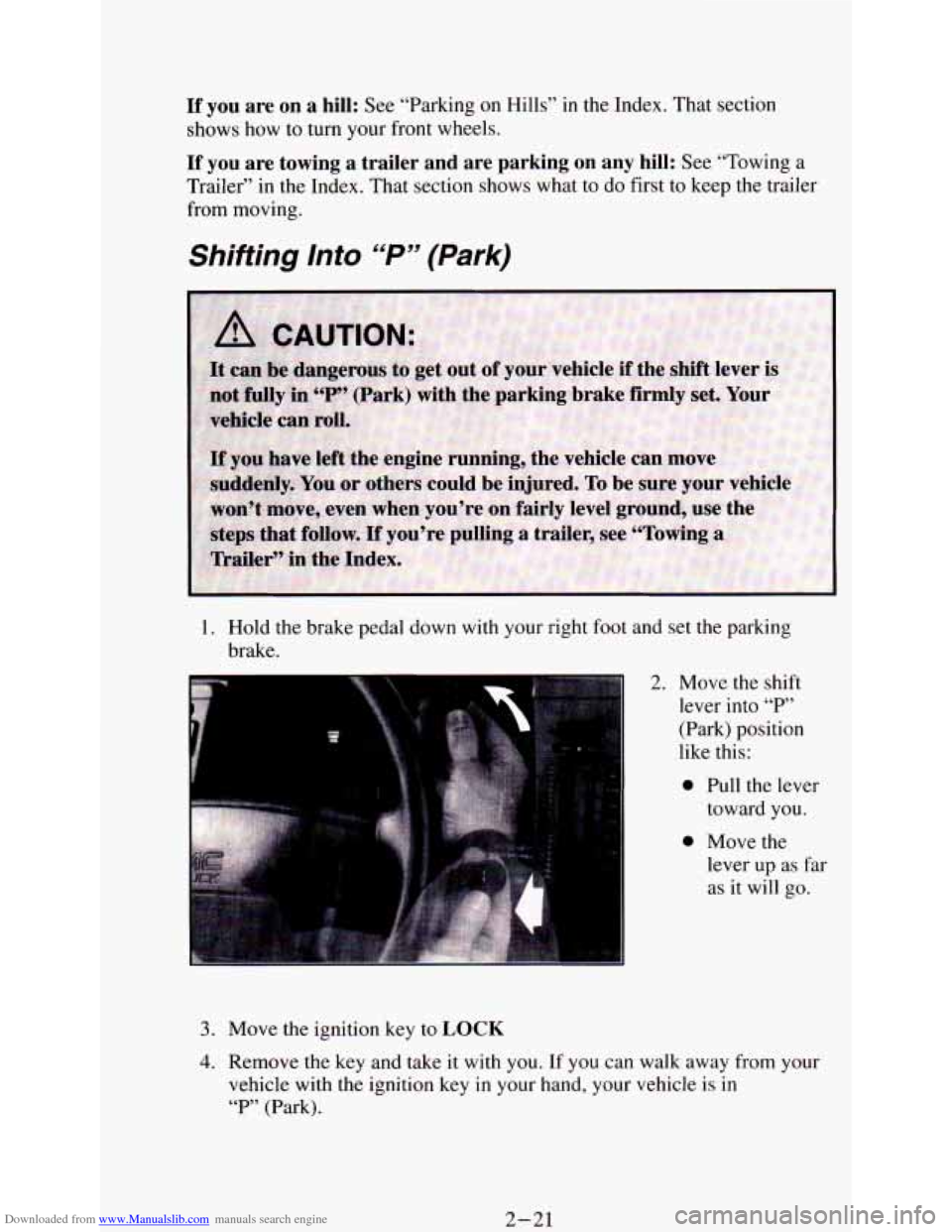
Downloaded from www.Manualslib.com manuals search engine If you are on a hill: See “Parking on Hills” in the Index. That section
shows how to turn your front wheels.
If you are towing a trailer and are parking on any hill: See “Towing a
Trailer” in the Index. That section shows what to do first to keep the trailer
from moving.
Shifting lnto “Pyy (Park)
1. Hold the brake pedal down with your right foot and set the parking
brake.
3. Move the ignition key to LOCK
2. Move the shift
lever into
“P’
(Park) position
like this:
0 Pull the lever
toward you.
0 Move the
lever up
as far
as it will go.
4. Remove the key and take it with you. If you can walk away from your
vehicle with the ignition key
in your hand, your vehicle is in
“P” (Park).
2-21
Page 82 of 340
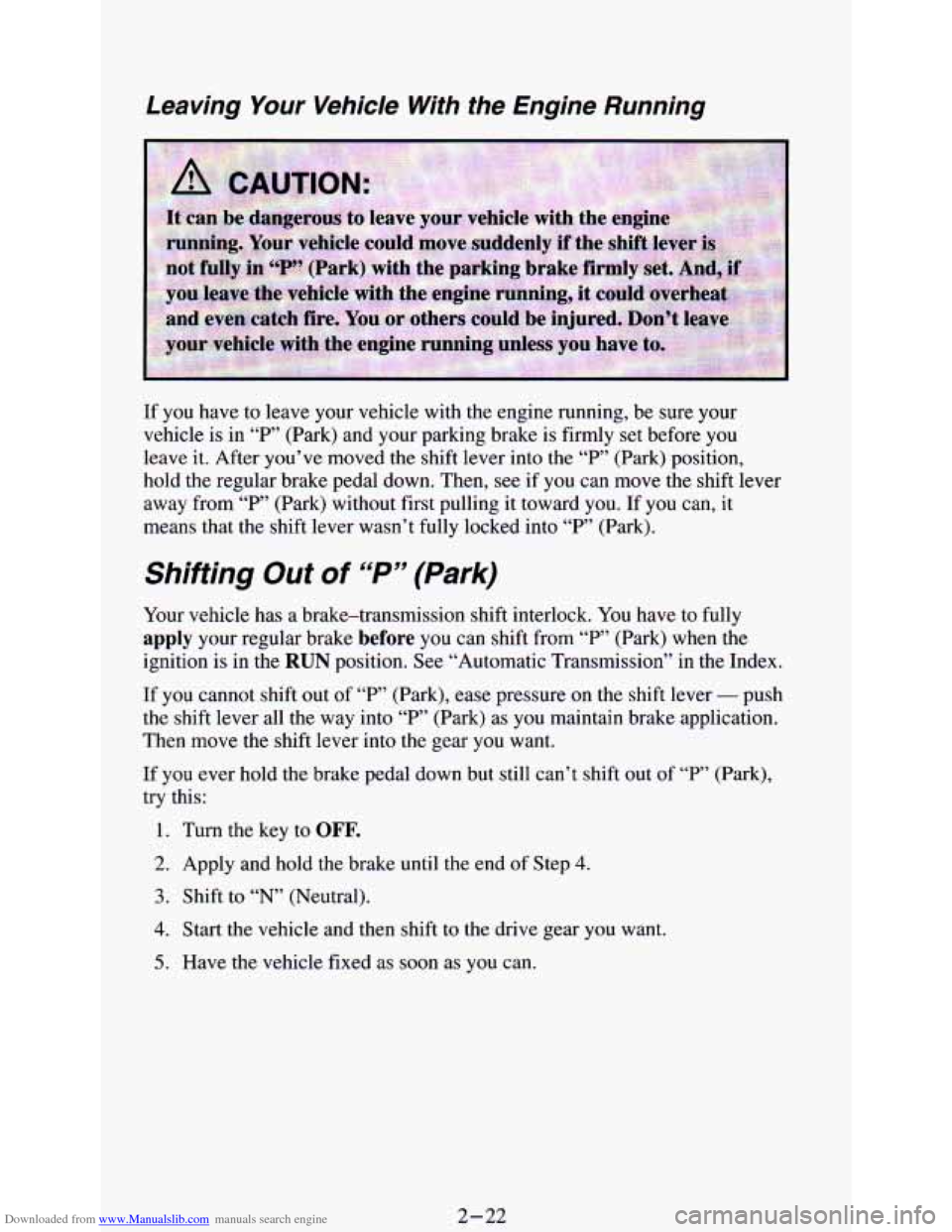
Downloaded from www.Manualslib.com manuals search engine Leaving Your Vehide With the Engine Running
If you have to leave your vehicle with the engine running, be sure your
vehicle is in “P” (Park) and your parking brake is firmly set before you
leave it. After you’ve moved the shift lever into the
“P” (Park) position,
hold the regular brake pedal down. Then, see if you can move the shift lever
away from
“F’” (Park) without first pulling it toward you. If you can, it
means that the shift lever wasn’t fully locked into
“P” (Park).
Shifting Out of “P” (Park)
Your vehicle has a brake-transmission shift interlock. You have to fully
apply your regular brake before you can shift from “P” (Park) when the
ignition is in the
RUN position. See “Automatic Transmission” in the Index.
If you cannot shift out of
“P” (Park), ease pressure on the shift lever - push
the shift lever all the way into
“P” (Park) as you maintain brake application.
Then move the shift lever into the gear you want.
If you ever hold the brake pedal down but still can’t shift out of “P” (Park),
try this:
1. Turn the key to OFF.
2. Apply and hold the brake until the end of Step 4.
3. Shift to “N’ (Neutral).
4. Start the vehicle and then shift to the drive gear you want.
5. Have the vehicle fixed as soon as you can.
2-22
Page 88 of 340
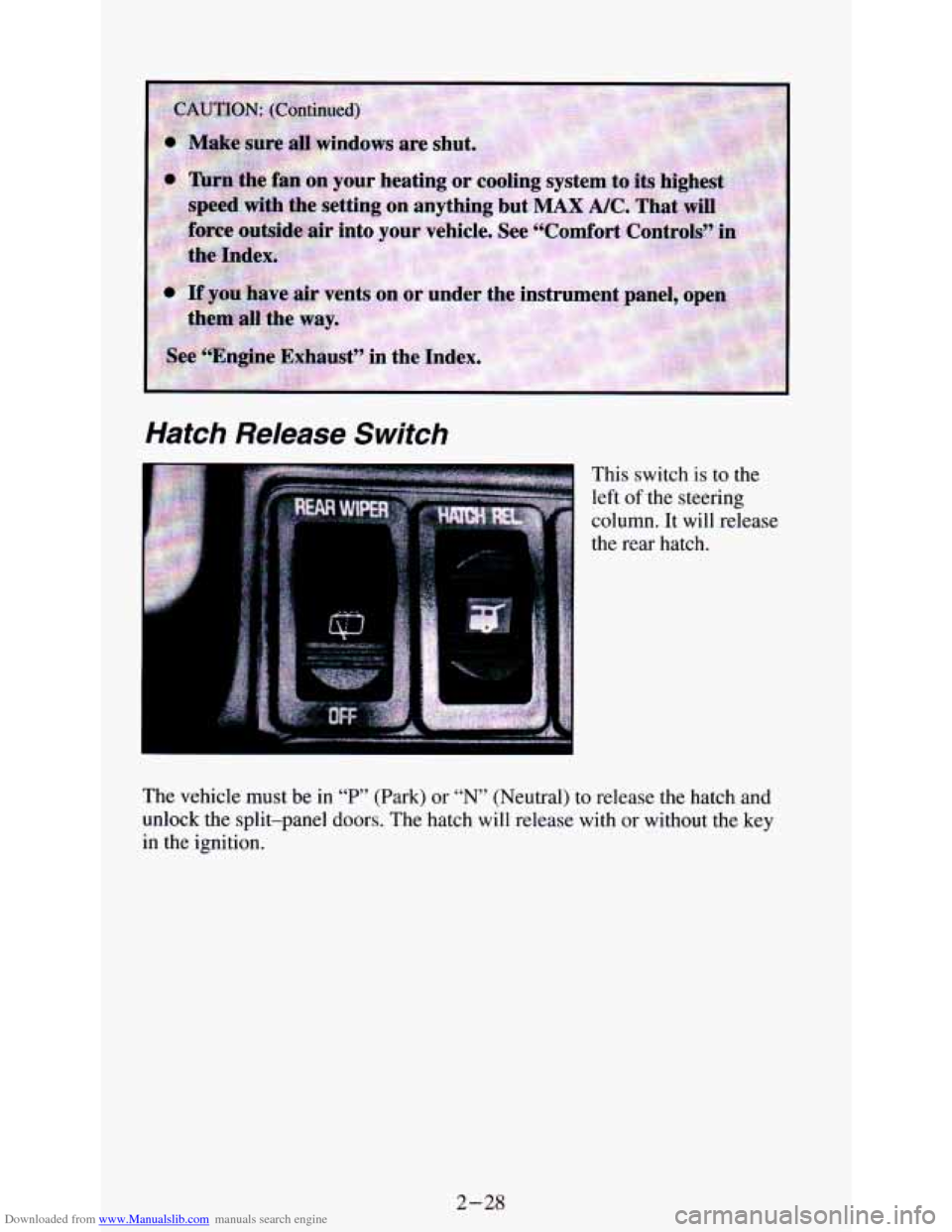
Downloaded from www.Manualslib.com manuals search engine Hatch Release Switch
This switch is to the
left of the steering
column. It will release
the rear hatch.
The vehicle must be
in “P’ (Park) or “N’ (Neutral) to release the hatch and
unlock the split-panel doors. The hatch will release with or without the key
in the ignition.
2-28
Page 115 of 340
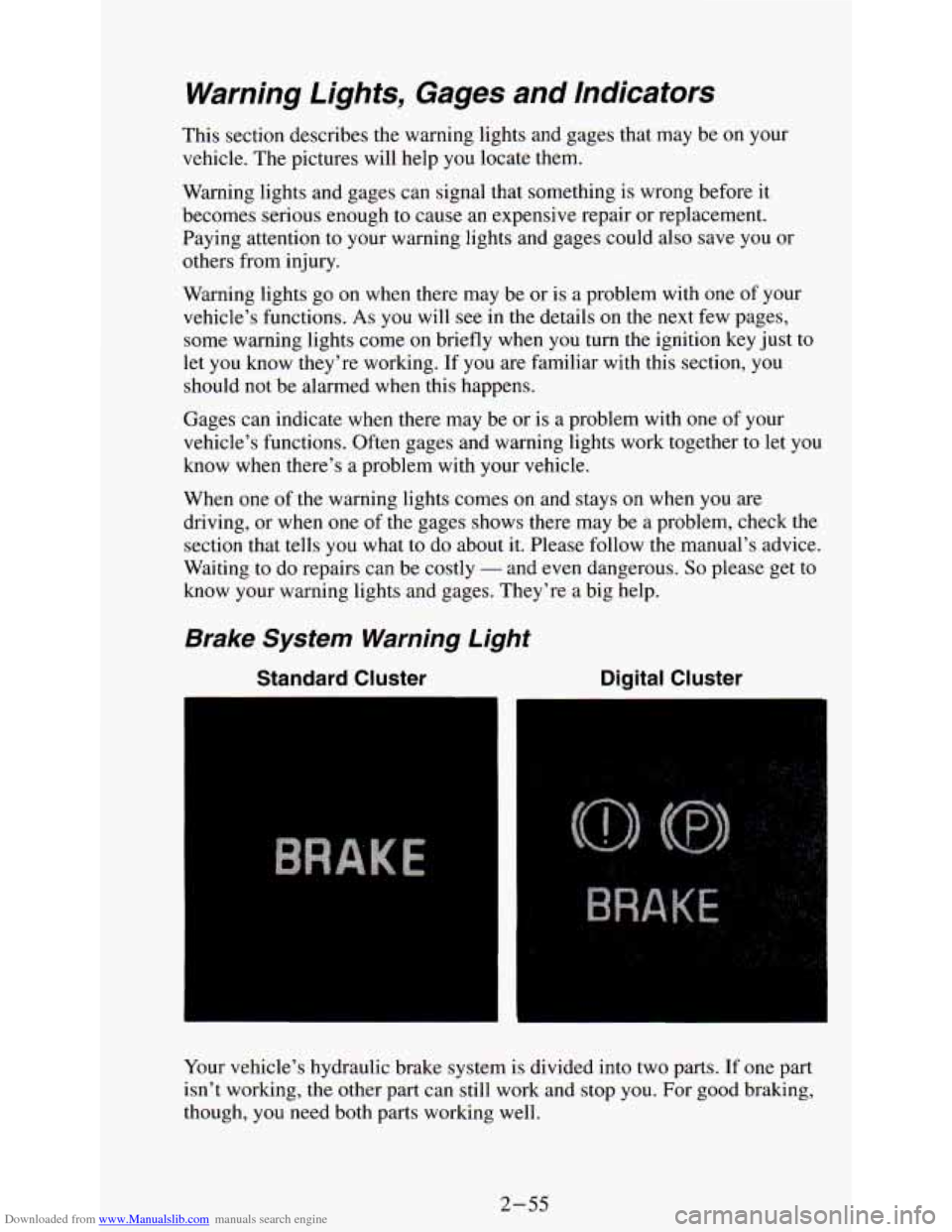
Downloaded from www.Manualslib.com manuals search engine Warning Lights, Gages and Indicators
This section describes the warning lights and gages that may be on your
vehicle. The pictures will help you locate them.
Warning lights and gages can signal that something is wrong before it
becomes serious enough to cause an expensive repair or replacement.
Paying attention
to your warning lights and gages could also save you or
others from injury.
Warning lights go on when there may be or is a problem with
one of your
vehicle’s functions.
As you will see in the details on the next few pages,
some warning lights come on briefly when
you turn the ignition key just to
let you know they’re working. If you are familiar with this section, you
should not be alarmed when this happens.
Gages can indicate when there may be or
is a problem with one of your
vehicle’s functions. Often gages and warning lights work together to let you
know when there’s a problem with your vehicle.
When one of the warning lights comes
on and stays on when you are
driving, or when one
of the gages shows there may be a problem, check the
section that tells you what
to do about it. Please follow the manual’s advice.
Waiting to do repairs can be costly
- and even dangerous. So please get to
know your warning lights and gages. They’re a big help.
Brake System Warning Light
Standard Cluster Digital Cluster
Your
vehicle’s hydraulic brake system is divided into two parts. If one part
isn’t working,
the other part can still work and stop you. For good braking,
though,
you need both parts working well.
2-55
Page 151 of 340
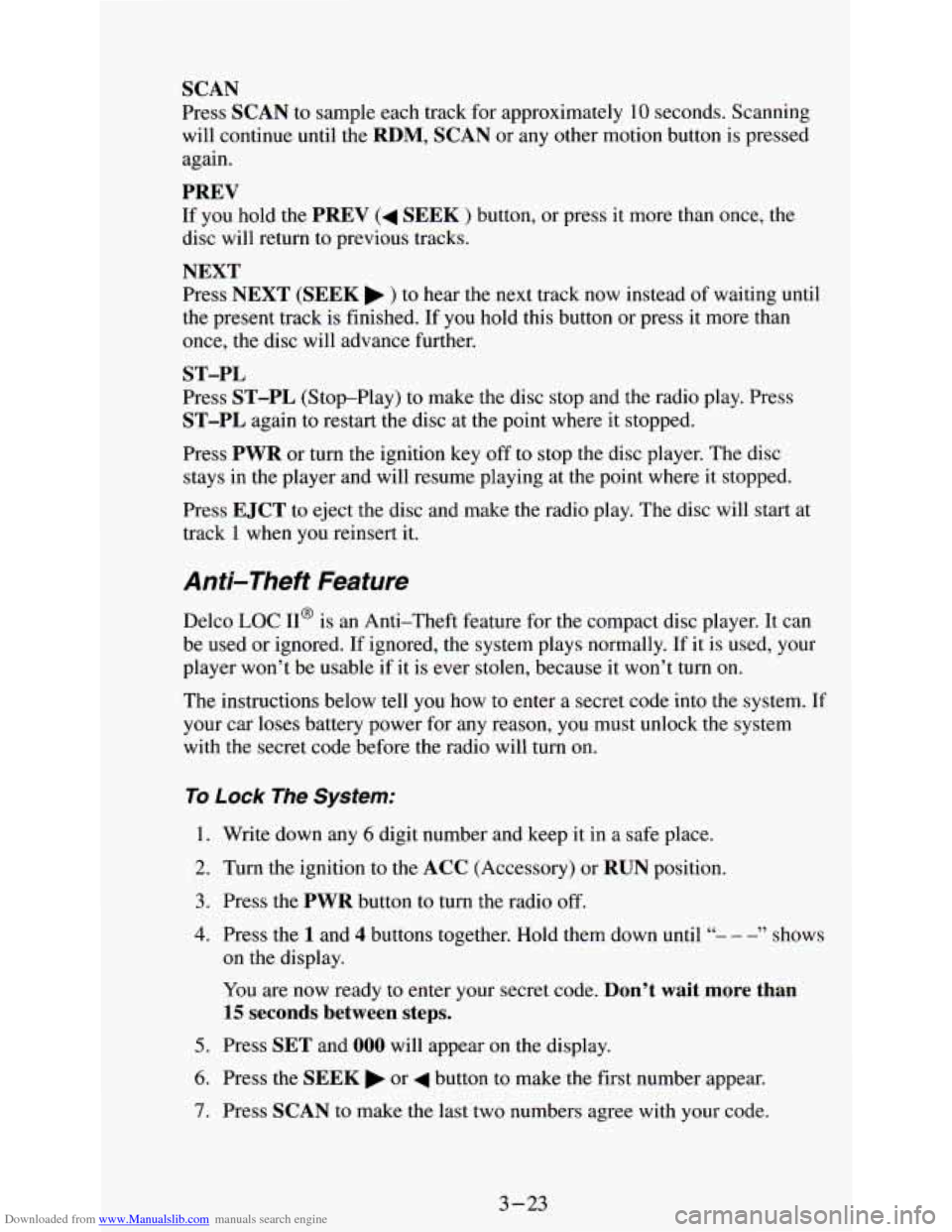
Downloaded from www.Manualslib.com manuals search engine SCAN
Press SCAN to sample each track for approximately 10 seconds. Scanning
will continue until the
RDM, SCAN or any other motion button is pressed
again.
PREV
If you hold the PREV (4 SEEK ) button, or press it more than once, the
disc will return to previous tracks.
NEXT
Press NEXT (SEEK b ) to hear the next track now instead of waiting until
the present track
is finished. If you hold this button or press it more than
once, the disc will advance further.
ST-PL
Press ST-PL (Stop-Play) to make the disc stop and the radio play. Press
ST-PL again to restart the disc at the point where it stopped.
Press
PWR or turn the ignition key off to stop the disc player. The disc
stays in the player and will resume playing at the point where
it stopped.
Press
EJCT to eject the disc and make the radio play. The disc will start at
track
1 when you reinsert it.
Anti-Theft Feature
Delco LOC II@ is an Anti-Theft feature for the compact disc player. It can
be used or ignored.
If ignored, the system plays normally. If it is used, your
player won’t be usable if
it is ever stolen, because it won’t turn on.
The instructions below tell you how
to enter a secret code into the system. If
your car loses battery power for any reason, you must unlock the system
with the secret code before
the radio will turn on.
To Lock The System:
1. Write down any 6 digit number and keep it in a safe place.
2. Turn the ignition to the ACC (Accessory) or RUN position.
3. Press the PWR button to turn the radio off.
4. Press the 1 and 4 buttons together. Hold them down until “- - -” shows
on the display.
You are now ready to enter your secret code. Don’t wait more than
15 seconds between steps.
5. Press SET and 000 will appear on the display.
6. Press the SEEK b or 4 button to make the first number appear.
7. Press SCAN to make the last two numbers agree with your code.
3-23
Page 157 of 340
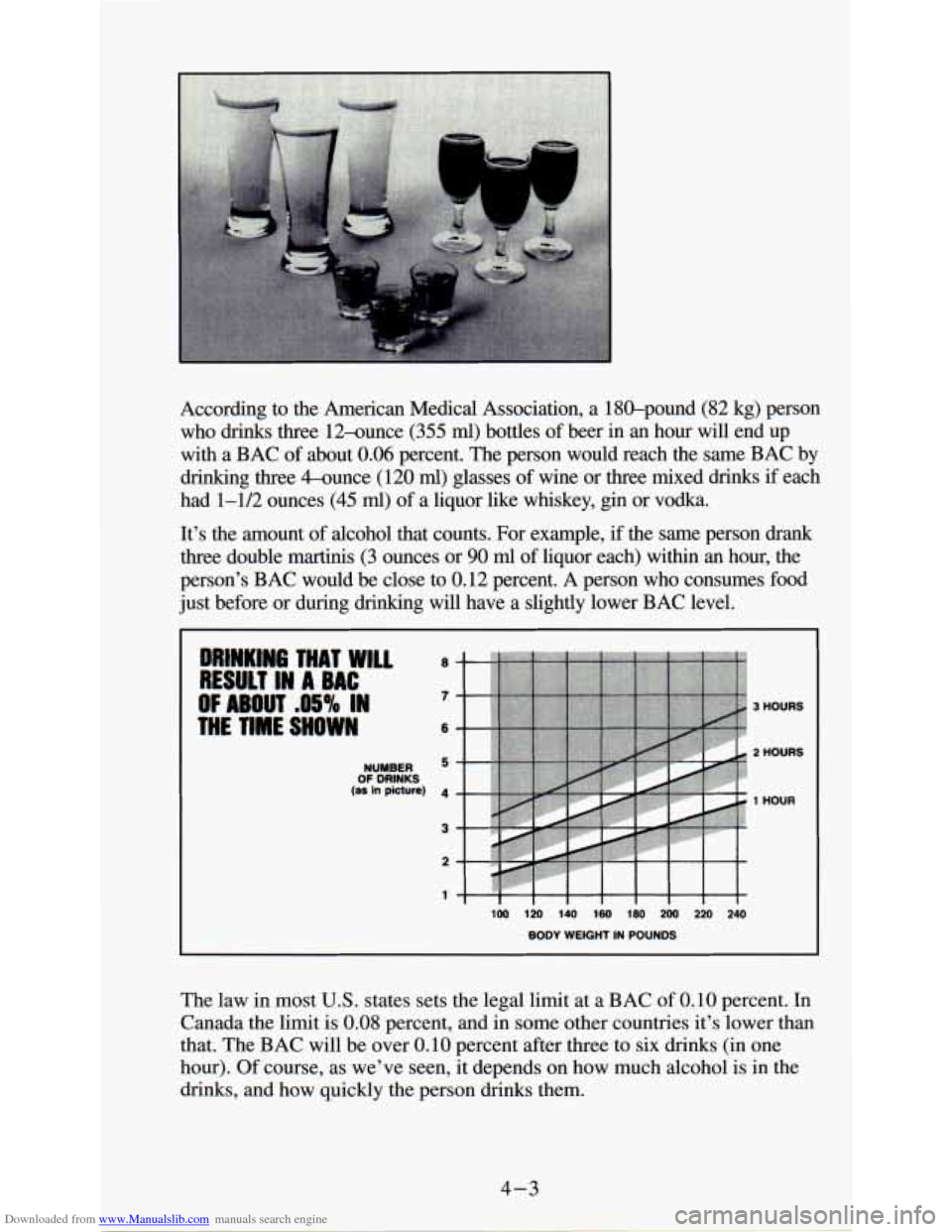
Downloaded from www.Manualslib.com manuals search engine 1 (82 kg
According to the American Medical Association, a 180-pounc ;) person
who drinks three 12-ounce
(355 ml) bottles of beer in an hour will end up
with a BAC
of about 0.06 percent. The person would reach the same BAC by
drinking three LCounce (120
ml) glasses of wine or three mixed drinks if each
had 1-1/2 ounces
(45 ml) of a liquor like whiskey, gin or vodka.
It’s the amount of alcohol that counts. For example,
if the same person drank
three double martinis (3 ounces or 90 ml of liquor each) within an hour, the
person’s BAC would be close
to 0.12 percent. A person who consumes food
just before or during drinking will have a slightly lower BAC level.
3 HOURS
1 HOURS
1 HOUR
The law in most U.S. states sets the legal limit at a BAC of 0.10 percent. In
Canada the limit is
0.08 percent, and in some other countries it’s lower than
that. The BAC will be over 0.10 percent after three to six drinks (in one
hour). Of course, as we’ve seen, it depends on how much alcohol is in the
drinks, and how quickly the person
drinks them.
4-3
Page 186 of 340
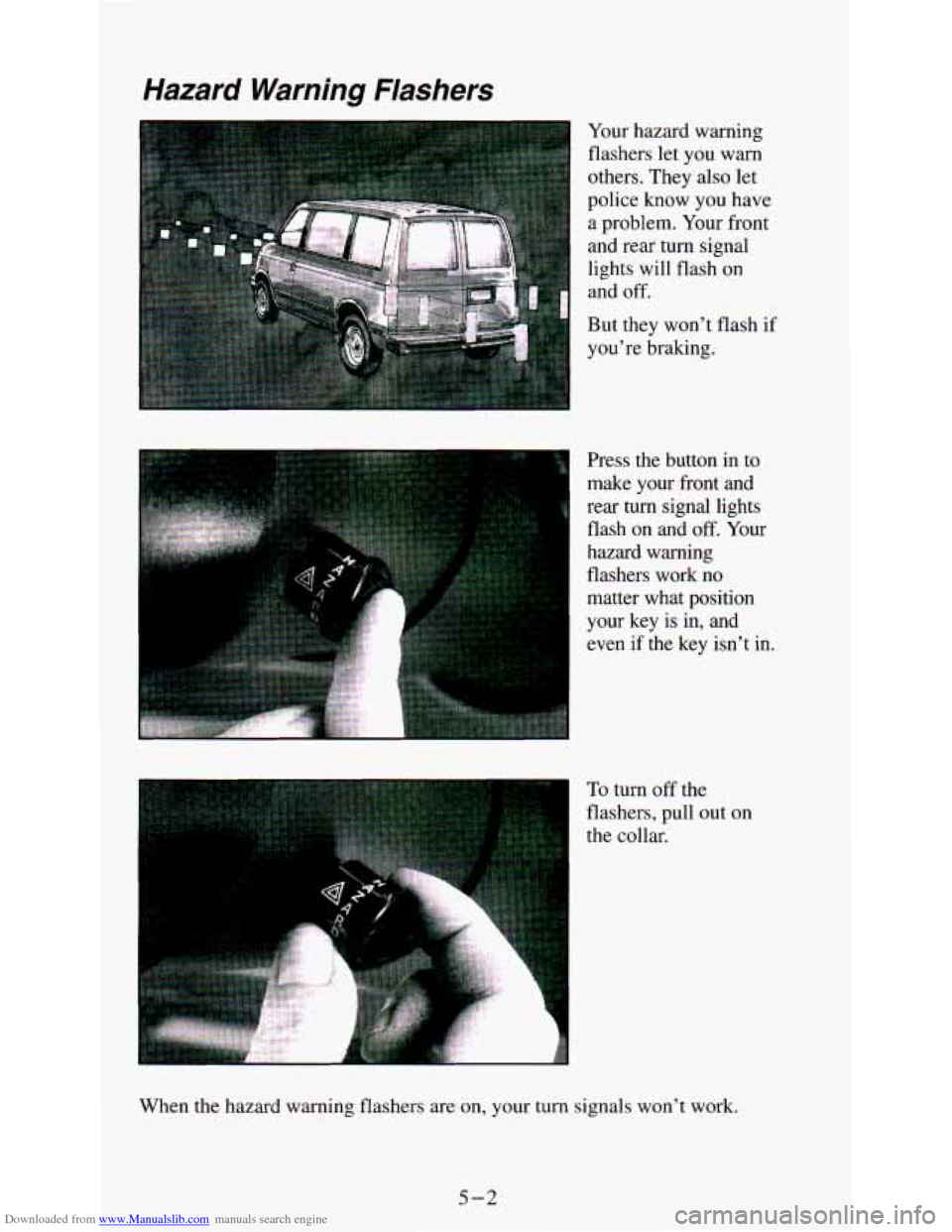
Downloaded from www.Manualslib.com manuals search engine Hazard Warning Flashers
.I - -- .‘ -----
others. They also let
police know you have
a problem. Your front
and rear turn signal
lights will flash on
and
off.
But they won’t flash if
you’re braking.
. :
Press the button in to
make your front and
rear turn signal lights
flash on
and off. Your
hazard warning
flashers work
no
matter what position
your key is in, and
even
if the key isn’t in.
To turn off the
flashers, pull out on
the collar.
When the hazard warning flashers are on, your turn signals won’t work.
5-2